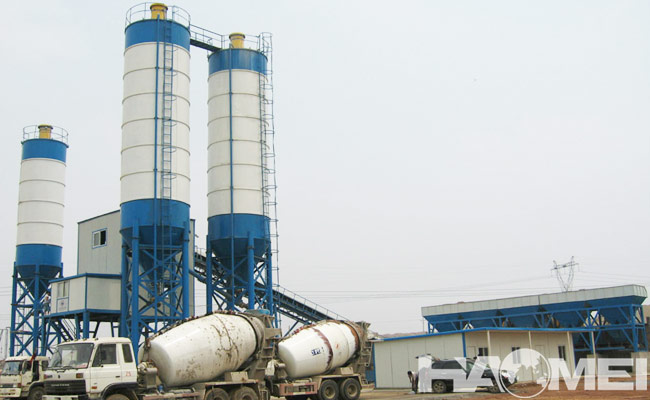Wet Batching Plants
Writer:Admin Time:22/05/17The wet batching plants are the most common seen concrete batching plant type in nowadays construction equipment market. The concrete mixture produced by wet concrete batching plant are transport by concrete mixer truck in wet state. In the case of long-distance transportation and supply, replacing traditional powdered cement in the form of concrete has many advantages:

1, It can greatly reduce the freight and save the transportation capacity. About 30% of the transportation capacity of ordinary cement and slag cement is consumed in the transportation of slag and other various additives. In the areas where the cement demand is large, the industrial base is mostly good, and there is a large amount of industrial waste in the local area. If the clinker is crushed in the use area, the type of mixed material can be selected according to the local resource conditions, which saves consumption. Capacity and shipping on mixed materials.
2, According to the actual local needs, a large amount of mixed materials can be added to produce cheap low-grade concrete, and varieties of low-grade concrete can be developed to meet the needs to a greater extent on the basis of the existing production capacity. The average grade of concrete produced by large and medium-sized wet batching plants in my country increases year by year. However, at present, the departments that use concrete in our country need a lot of concrete with lower grades, and most construction departments do not add mixed materials on site to reduce the technical strength and equipment of concrete grades. Therefore, they have to use concrete with higher grades, cause a lot of waste. If the concrete is transported over a long distance and processed and pulverized in the area of use, concrete of various grades can be produced according to actual needs, and the quantity of concrete transported over a long distance can be reduced.
3, It is easy to achieve high-volume, high-efficiency transportation at a lower cost. From the perspective of the overall interests of the country, the transportation method with relatively low utilization rate is obviously not the development direction. If it adopts the form of conveying wet concrete, it can make full use of the existing loading and unloading equipment in the concrete batching plant, field and warehouse, and can also use ordinary wagons for shipment. Compared with the way of bulk cement, it has better technical and economic effects and is more suitable for my country's national conditions.
4, It can greatly reduce the transportation loss of cement. The hydraulic properties of cement are only manifested after it is fully ground, while the unground clinker has strong stability against moisture. Conveying clinker can basically prevent losses due to moisture. In addition, granular clinker is not as easily lost as powdered cement.
5, It can better connect production and demand, which is convenient for users. By means of long-distance transportation of concrete, a fixed direct channel can be formed between the wet batching plants and the limited clinker crushing plant, and logistics with better economic effects can be realized. Users can also order directly from the local clinker crushing factory without leaving the area, so it is easier to communicate the relationship between production and demand, which has obvious advantages. This is beneficial for strengthening planning, simplifying procedures, and ensuring supply.
- Previous:Precast Concrete Batching Plant...
- Next:Concrete Mixer Machine Price In Kenya...

